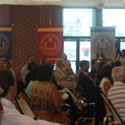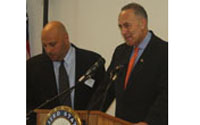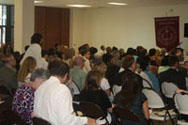

U.S. Sen. Schumer hosts meeting to connect Long Island’s Main Streets to WashingtonNearly 20 Long Island municipalities present downtown plans to four Federal Agencies to “cut the red tape,” bring infrastructure support for Long Island.
Nearly twenty LI Town’s and Villages presented 25 revitalization and infrastructure projects to members of high-level federal leadership, including the Interagency Partnership for Sustainable Communities. In addition to the municipalities, many local business groups, civic associations and government officials also attended. In total, there were over 350 representatives in the room at Briarcliff College in downtown Patchogue.
Last June, EPA, DOT, and HUD formed the Partnership for Sustainable Communities to promote the coordination of downtown housing, transportation and environmental investments at the local planning level. To date, the Partnership has held two similar meetings: one in an urban area and one in a rural area. This was the first official meeting of the new federal partnership in America’s suburbs. This event was coordinated in partnership with Vision Long Island, the National Center for Suburban Studies at Hofstra University and Sustainable Long Island. Sen. Schumer pushed for the creation of the Partnership because he saw the need to revitalize downtowns through competitiveness, better access to new job opportunities and improved transportation options. All of these are available within a well-planned walkable downtown. This is especially crucial, considering the last census found that over half of the US population lives in suburban areas. Long Island, often called America's "first suburb," is the best place to start the Senator's efforts. If it works here, it can serve a model for the rest of the country.
Next, members of the Federal Interagency Partnership for Sustainable Communities presented:
Adolfo Carrion, new to his position as Regional Administrator for HUD, spoke about the importance of a “bottom-up” or “place-based” approach to local issues. He expressed his interest in coming back to Long Island in order to tour our area and learn more about the issues we face.
After the morning’s presentations, the group split into three breakout panels, where the invited municipalities presented their projects to the federal agencies. Municipalities presenting included: Town of Babylon, Town of Brookhaven, Town of Riverhead, Town of Southampton, Town of Islip, Town of Hempstead, Town of Huntington, Town of North Hempstead, City of Glen Cove, Village of Patchogue, Village of Mineola, City of Long Beach, Village of Rockville Centre, Village of Lynbrook, Village of Farmingdale, Village of New Hyde Park, Village of Bayville and Village of Port Jefferson. CITY OF GLEN COVE
TOWN OF RIVERHEAD
TOWN OF SOUTHAMPTON TOWN OF ISLIP The Town also addressed the underserved rental market. “Homeownership is not an objective of everybody.” It is important that we provide housing options to fulfill different market needs. TOWN OF HEMPSTEAD
Aloise also addressed the commercial development along the Route 110 corridor in Melville and plans to expand employment in that area. TOWN OF NORTH HEMPSTEAD VILLAGE OF PATCHOGUE VILLAGE OF MINEOLA VILLAGE OF ROCKVILLE CENTRE VILLAGE OF LYNBROOK VILLAGE OF FARMINGDALE VILLAGE OF NEW HYDE PARK VILLAGE OF PORT JEFFERSON Long Island Elected officials in attendance included: Quotes from Coordinating Groups: “This event connects Long Island's main streets to Washington. The smallest municipalities are connecting to Federal agencies, which has not happened in a coordinated fashion, not just on Long Island but any suburban area in the nation. The strength of Long Island resides in its many downtowns. This new Federal partnership could provide the resources necessary to assist the revitalization of our downtowns and support needed sewer and transit infrastructure,” said Eric Alexander, Executive Director of Vision Long Island. “Finally, suburban problems are getting noticed,” said Sarah Lansdale, Executive Director of Sustainable Long Island. “Long Island’s downtown revitalization and transit-oriented development plans need more than just local officials and community planners fighting for them; these plans need federal assistance. Long Island has the ingredients to become the epitome of what the suburbs should be, but it is much easier said than done. Senator Schumer and The Partnership for Sustainable Communities have taken a tremendous step forward in identifying which communities haven’t received a fair share of the limited resources available."
|
SMART GROWTH NEWS Newsletter Editor: Michelle Dutchen, Director of Communications We strive to provide continued quality publications such as this each week. If you have any news or events that you would like to add to our newsletter, submit them to info@visionlongisland.org for consideration. If you are interested in becoming a newsletter or news blast sponsor, please call the office at 631-261-0242 for rates and opportunities. For more information about Vision Long Island, visit visionlongisland.org or contact us at: |
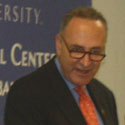 On Monday, August 9th, U.S. Senator Charles Schumer held a meeting with members of the Partnership for Sustainable Communities (a collaboration between the Environmental Protection Agency (EPA), Department of Transportation (DOT), and Department of Housing and Urban Development (HUD)) and Long Island leaders to discuss and better assist in the issues facing Long Island's re-emerging walkable downtowns.
On Monday, August 9th, U.S. Senator Charles Schumer held a meeting with members of the Partnership for Sustainable Communities (a collaboration between the Environmental Protection Agency (EPA), Department of Transportation (DOT), and Department of Housing and Urban Development (HUD)) and Long Island leaders to discuss and better assist in the issues facing Long Island's re-emerging walkable downtowns. “Long Island is the oldest suburb in the nation and it the perfect place for this first of its kind meeting to take place. Today’s meeting is putting Long Island’s downtown needs on the federal radar screen. We need to revitalize our downtown areas so that they thrive with new economic development, create jobs, and provide better transit options for commuters,” Schumer said. “These agencies should be commended for starting this Partnership, but there is much work to do in cutting through red tape and identifying a regional federal investment strategy. That is why this public meeting with the EPA, DOT, HUD and residents of Long Island is so essential.”
“Long Island is the oldest suburb in the nation and it the perfect place for this first of its kind meeting to take place. Today’s meeting is putting Long Island’s downtown needs on the federal radar screen. We need to revitalize our downtown areas so that they thrive with new economic development, create jobs, and provide better transit options for commuters,” Schumer said. “These agencies should be commended for starting this Partnership, but there is much work to do in cutting through red tape and identifying a regional federal investment strategy. That is why this public meeting with the EPA, DOT, HUD and residents of Long Island is so essential.”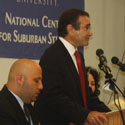 The morning started with a Federal Agency Panel. Hofstra’s Larry Levy opened the meeting. Senator Charles E. Schumer followed with an uplifting message on Smart Growth. In his speech, Senator Schumer discussed what he felt were the goals of the day’s conference: first, to establish a pattern of cooperation between the federal agencies and local governments, and second, to allow those at the local government level to communicate their needs to those at the federal level. Senator Schumer further stressed the importance of revitalizing Long Island to ensure that those who are raised on the Island can stay here.
The morning started with a Federal Agency Panel. Hofstra’s Larry Levy opened the meeting. Senator Charles E. Schumer followed with an uplifting message on Smart Growth. In his speech, Senator Schumer discussed what he felt were the goals of the day’s conference: first, to establish a pattern of cooperation between the federal agencies and local governments, and second, to allow those at the local government level to communicate their needs to those at the federal level. Senator Schumer further stressed the importance of revitalizing Long Island to ensure that those who are raised on the Island can stay here.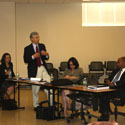 John Frece, Director of Sustainable Communities for the U.S. Environmental Protection Agency, addressed that carbon emission control cannot be done without effective policies to accommodate transportation and housing issues. The EPA aims to improve living conditions through better transportation systems, affordable housing, and better access to businesses. He also stresses that we ought to support existing communities first before expanding into greenfield development.
John Frece, Director of Sustainable Communities for the U.S. Environmental Protection Agency, addressed that carbon emission control cannot be done without effective policies to accommodate transportation and housing issues. The EPA aims to improve living conditions through better transportation systems, affordable housing, and better access to businesses. He also stresses that we ought to support existing communities first before expanding into greenfield development. 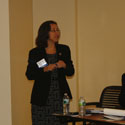 Shelley Poticha, Director for the Office of Sustainable Housing and Communities for U.S. Housing and Urban Development, described grants that are designed to fund communities by improving water infrastructures, transportation, infrastructure, environmental planning, housing, and community status through planning. The director also addressed the TIGER II grant from DOT, which is designed in line with the DOT-HUD-EPA partnership, as a competitive grant for transportation planning. The evaluation criteria will emphasize livability, sustainability, and long-term average cost reduction.
Shelley Poticha, Director for the Office of Sustainable Housing and Communities for U.S. Housing and Urban Development, described grants that are designed to fund communities by improving water infrastructures, transportation, infrastructure, environmental planning, housing, and community status through planning. The director also addressed the TIGER II grant from DOT, which is designed in line with the DOT-HUD-EPA partnership, as a competitive grant for transportation planning. The evaluation criteria will emphasize livability, sustainability, and long-term average cost reduction. 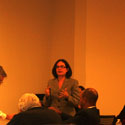 Beth Osbourne, Deputy Assistant Secretary for Transportation Policy for the U.S. Department of Transportation, reviewed the basic tenets of Smart Growth and then discussed why the federal government is so concerned about creating Smart Growth communities. She addressed how Smart Growth development assures that affordable housing is still affordable by containing the large percentage of a person's income that is typically dedicated to transportation. She also mentioned that tax payer money is saved because communities can better utilize the infrastructure that is already in place. Finally, she discussed how communities utilizing Smart Growth principles meet the demand of today’s market, which is no longer dominated by households with children.
Beth Osbourne, Deputy Assistant Secretary for Transportation Policy for the U.S. Department of Transportation, reviewed the basic tenets of Smart Growth and then discussed why the federal government is so concerned about creating Smart Growth communities. She addressed how Smart Growth development assures that affordable housing is still affordable by containing the large percentage of a person's income that is typically dedicated to transportation. She also mentioned that tax payer money is saved because communities can better utilize the infrastructure that is already in place. Finally, she discussed how communities utilizing Smart Growth principles meet the demand of today’s market, which is no longer dominated by households with children. Judith Enck, Regional Administrator for the EPA, addressed the importance of education and law enforcement in urban centers. She also discussed how the 400-mile shoreline of Long Island makes it vulnerable to the changing climate. There are many water issues, such as pollution in ground water and issues with the Pine Barrens. Most importantly, the Obama administration emphasizes a bottom-up approach toward improving communities, utilizing fix-it-first policies and community partnerships.
Judith Enck, Regional Administrator for the EPA, addressed the importance of education and law enforcement in urban centers. She also discussed how the 400-mile shoreline of Long Island makes it vulnerable to the changing climate. There are many water issues, such as pollution in ground water and issues with the Pine Barrens. Most importantly, the Obama administration emphasizes a bottom-up approach toward improving communities, utilizing fix-it-first policies and community partnerships.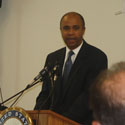
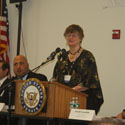
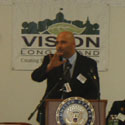 The speakers then took part in a panel discussion, moderated by Vision Long Island’s Eric Alexander and Sustainable Long Island’s Sarah Lansdale, and concluded with a question and answer session from the audience. Questions ranged from DOT’s policies on roadway design to streamlining the Federal bureaucracy. At one point, Riverhead Supervisor Sean Walter literally got on his knees to beg the EPA not to fine his Town. Eric Alexander thanked the federal officials for coming back to Long Island, as the modern-day Smart Growth movement started with meetings with the EPA Office of Smart Growth in 1997. Alexander stated that "much work has been done in Washington to get federal agencies organized to support Smart Growth. What you will find today is that Long Island community, government and business leaders have done some work as well to plan for Smart Growth. We need your help in implementation."
The speakers then took part in a panel discussion, moderated by Vision Long Island’s Eric Alexander and Sustainable Long Island’s Sarah Lansdale, and concluded with a question and answer session from the audience. Questions ranged from DOT’s policies on roadway design to streamlining the Federal bureaucracy. At one point, Riverhead Supervisor Sean Walter literally got on his knees to beg the EPA not to fine his Town. Eric Alexander thanked the federal officials for coming back to Long Island, as the modern-day Smart Growth movement started with meetings with the EPA Office of Smart Growth in 1997. Alexander stated that "much work has been done in Washington to get federal agencies organized to support Smart Growth. What you will find today is that Long Island community, government and business leaders have done some work as well to plan for Smart Growth. We need your help in implementation."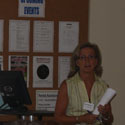 Panel 1 began with the City of Glen Cove, who focused on the Waterfront Redevelopment Area. RXR Glen Isle’s Matt Frank and Glen Cove Community Development Agency’s Kelly Morris led the discussion of the plans and needs for the former brownfield site. The team mentioned several additional funding streams that they were seeking and having trouble attaining, including $3 million in additional funding to complete the Commuter Ferry Terminal, funds for road reconstruction projects, about $10 million to complete the esplanade and waterfront park, $6.4 million to increase drinking water capacity, about $2 million to improve stormwater drainage and more. They mentioned that “as a small municipality, the City of Glen Cove faces communication and representation challenges with The Department of Transportation that are not faced by larger municipalities that have representation of the regional Transportation Coordination Committee. These challenges have over time cost the city months of work and hundreds of thousands of dollars.”
Panel 1 began with the City of Glen Cove, who focused on the Waterfront Redevelopment Area. RXR Glen Isle’s Matt Frank and Glen Cove Community Development Agency’s Kelly Morris led the discussion of the plans and needs for the former brownfield site. The team mentioned several additional funding streams that they were seeking and having trouble attaining, including $3 million in additional funding to complete the Commuter Ferry Terminal, funds for road reconstruction projects, about $10 million to complete the esplanade and waterfront park, $6.4 million to increase drinking water capacity, about $2 million to improve stormwater drainage and more. They mentioned that “as a small municipality, the City of Glen Cove faces communication and representation challenges with The Department of Transportation that are not faced by larger municipalities that have representation of the regional Transportation Coordination Committee. These challenges have over time cost the city months of work and hundreds of thousands of dollars.”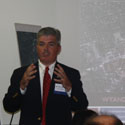
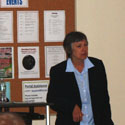 Three Town Council members spoke next for the Town of Brookhaven. Councilwoman Connie Kepert began with the Middle County Road Land Use Plan, which seeks to reduce strip commercial zoning, preserve open space, reduce congestion and more. Councilwoman Kepert said that there has been progress, though “We need to do more than up-zone and preserve; we need to funnel development into mixed-use centers.” Specific needs include $2.5 million in funding for a bypass for Routes 112 and 25 in Coram, $6.4 million for continuous sidewalks and bike lanes on Middle County Road and pedestrian improvements such as medians that provide safe places to bike and walk.
Three Town Council members spoke next for the Town of Brookhaven. Councilwoman Connie Kepert began with the Middle County Road Land Use Plan, which seeks to reduce strip commercial zoning, preserve open space, reduce congestion and more. Councilwoman Kepert said that there has been progress, though “We need to do more than up-zone and preserve; we need to funnel development into mixed-use centers.” Specific needs include $2.5 million in funding for a bypass for Routes 112 and 25 in Coram, $6.4 million for continuous sidewalks and bike lanes on Middle County Road and pedestrian improvements such as medians that provide safe places to bike and walk. Councilwoman Kathleen Walsh spoke about the Ronkonkoma Hub. The widely used train station is disconnected from the nearby airport. Plans include mixed-use development and workforce housing. The Councilwoman added that sewering is the key to success.
Councilwoman Kathleen Walsh spoke about the Ronkonkoma Hub. The widely used train station is disconnected from the nearby airport. Plans include mixed-use development and workforce housing. The Councilwoman added that sewering is the key to success.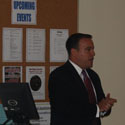 Councilman Dan Panico presented on two important issues facing the Mastic-Shirley community. First, there is a strong need for sewers in an area that seeks new development but is plagued by pollution, mainly caused by cesspools. He also spoke about transportation: there are currently only two ways in and out of Mastic Beach and the penninsula. Roads that dead-end now could pass through the train tracks with raised crossings, easing congestion while providing critical emergency storm evacuation routes. Councilman Panico said, "the Sixth Council District is in need of direct financial assistance from the state and federal governments for projects such as sewage treatment, and emergency evacuation in terms of dealing with the lack of sufficient railroad grade crossings south of Montauk Highway in the Mastic and Shirley Community."
Councilman Dan Panico presented on two important issues facing the Mastic-Shirley community. First, there is a strong need for sewers in an area that seeks new development but is plagued by pollution, mainly caused by cesspools. He also spoke about transportation: there are currently only two ways in and out of Mastic Beach and the penninsula. Roads that dead-end now could pass through the train tracks with raised crossings, easing congestion while providing critical emergency storm evacuation routes. Councilman Panico said, "the Sixth Council District is in need of direct financial assistance from the state and federal governments for projects such as sewage treatment, and emergency evacuation in terms of dealing with the lack of sufficient railroad grade crossings south of Montauk Highway in the Mastic and Shirley Community."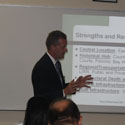 Town of Riverhead Supervisor Sean Walter was ready to stop planning and start implementing: “Riverhead has it all in terms of visioning and planning. We’re done with visioning and planning,” said the Supervisor. He outlined the progress in the downtown with the new hotel in construction at Atlantis Marine World, the Summerwind workforce housing project and the renovation of the Suffolk Theatre among other efforts.
Town of Riverhead Supervisor Sean Walter was ready to stop planning and start implementing: “Riverhead has it all in terms of visioning and planning. We’re done with visioning and planning,” said the Supervisor. He outlined the progress in the downtown with the new hotel in construction at Atlantis Marine World, the Summerwind workforce housing project and the renovation of the Suffolk Theatre among other efforts. The room closed with a presentation by Paul Beyer, NYS Director of Smart Growth for the NYS Smart Growth Cabinet. Beyer reviewed the recently passed NYS Smart Growth Public Infrastructure Policy Act and discussed its benefits for local communities. He called the law a “behavior changer.” Beyer called Smart Growth “the approach of the future,” and concluded, “I think we’re all aligned, for once: local, state, and federal.” Paul Beyer thanked Vision Long Island and other organizations for the successful package of the Public Infrastructure Act.
The room closed with a presentation by Paul Beyer, NYS Director of Smart Growth for the NYS Smart Growth Cabinet. Beyer reviewed the recently passed NYS Smart Growth Public Infrastructure Policy Act and discussed its benefits for local communities. He called the law a “behavior changer.” Beyer called Smart Growth “the approach of the future,” and concluded, “I think we’re all aligned, for once: local, state, and federal.” Paul Beyer thanked Vision Long Island and other organizations for the successful package of the Public Infrastructure Act.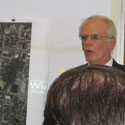 The Town of Islip’s Gene Murphy presented the “Village Place” proposal accommodates 3-and-4-story apartments with retail and office spaces. The Town also plans to create a vibrant pedestrian plaza on Park Avenue that will be closed to vehicles. However, Islip needs funding to make these projects more affordable.
The Town of Islip’s Gene Murphy presented the “Village Place” proposal accommodates 3-and-4-story apartments with retail and office spaces. The Town also plans to create a vibrant pedestrian plaza on Park Avenue that will be closed to vehicles. However, Islip needs funding to make these projects more affordable.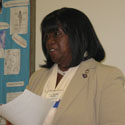 Councilwoman Dorothy Goosby presented that the Town of Hempstead has put in much effort into improving its environment and community. The Town has a hydrogen plant and a solar sea clam and oyster facility and half of the Town Hall now runs on solar power. A specific update and presentation were made about the Roosevelt revitalization initiative. The Town also awarded a property to Habitat for Humanity for building green affordable housing. Some community centers and streetscapes have been upgraded in addition new health care centers, daycare centers and other support services were part of the revitalization process.
Councilwoman Dorothy Goosby presented that the Town of Hempstead has put in much effort into improving its environment and community. The Town has a hydrogen plant and a solar sea clam and oyster facility and half of the Town Hall now runs on solar power. A specific update and presentation were made about the Roosevelt revitalization initiative. The Town also awarded a property to Habitat for Humanity for building green affordable housing. Some community centers and streetscapes have been upgraded in addition new health care centers, daycare centers and other support services were part of the revitalization process.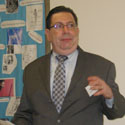 TOWN OF HUNTINGTON
TOWN OF HUNTINGTON Michael Levine, Planning Director for the Town of North Hempstead, spoke about the redevelopment efforts in New Cassel, a racially and ethnically diverse hamlet of 13,000 residents. The area has completed 200 new apartment units and 4000 square feet of new commercial space, which should include a bank, grocery store, and pharmacy. Efforts have also begun to redevelop many abandoned properties through an EPA Brownfield Pilot Grant and state Brownfield Opportunity Area funding and to reconstruct Prospect Avenue to include bicycle lanes, wider sidewalks, pedestrian bulb-outs, new lighting and community artwork. A new community center is also in the planning stages as well. Mr. Levine specifically spoke of the challenges of managing the multiple regulations of differing Federal agencies and grant programs that are at times conflicting.
Michael Levine, Planning Director for the Town of North Hempstead, spoke about the redevelopment efforts in New Cassel, a racially and ethnically diverse hamlet of 13,000 residents. The area has completed 200 new apartment units and 4000 square feet of new commercial space, which should include a bank, grocery store, and pharmacy. Efforts have also begun to redevelop many abandoned properties through an EPA Brownfield Pilot Grant and state Brownfield Opportunity Area funding and to reconstruct Prospect Avenue to include bicycle lanes, wider sidewalks, pedestrian bulb-outs, new lighting and community artwork. A new community center is also in the planning stages as well. Mr. Levine specifically spoke of the challenges of managing the multiple regulations of differing Federal agencies and grant programs that are at times conflicting.

